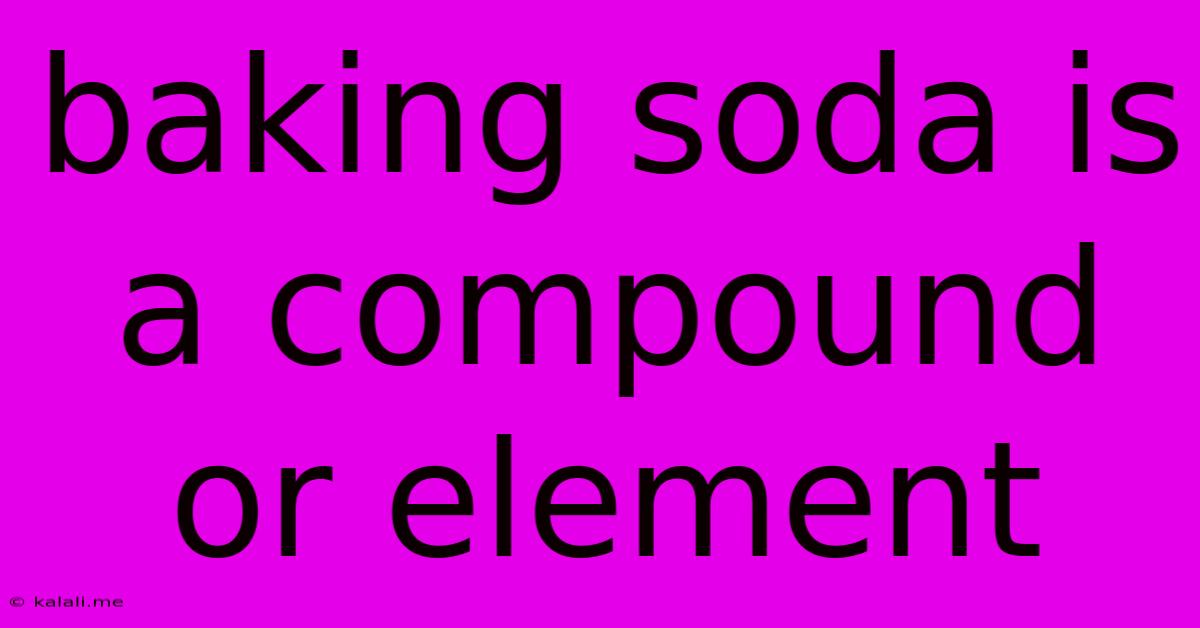Baking Soda Is A Compound Or Element
Kalali
May 09, 2025 · 3 min read

Table of Contents
Baking Soda: Compound or Element? Understanding the Chemistry
Baking soda, a staple in many kitchens, is often used in baking, cleaning, and even as a deodorizer. But have you ever wondered what it actually is from a chemical perspective? Is baking soda an element or a compound? The answer is it's a compound. This article will delve into the chemistry of baking soda, explaining why it's classified as a compound and not an element. Understanding this fundamental difference is key to appreciating its versatility and various applications.
Baking soda, also known as sodium bicarbonate, is a chemical compound with the formula NaHCO₃. This formula tells us that each molecule of baking soda is made up of:
- One sodium atom (Na): An alkali metal, highly reactive.
- One hydrogen atom (H): The simplest and lightest element.
- One carbon atom (C): A non-metal crucial for organic life.
- Three oxygen atoms (O): A highly reactive non-metal essential for respiration.
The presence of multiple types of atoms bonded together chemically defines it as a compound, not an element. Elements, like hydrogen (H), oxygen (O), or sodium (Na), consist of only one type of atom. They cannot be broken down further through chemical means. Conversely, compounds, like baking soda, are formed when two or more different elements are chemically combined in a fixed ratio. This combination creates a new substance with unique properties different from its constituent elements.
What makes Baking Soda a Compound?
Several characteristics solidify baking soda's classification as a compound:
-
Fixed ratio of elements: The formula NaHCO₃ always holds true. This fixed ratio of sodium, hydrogen, carbon, and oxygen atoms differentiates it from a mixture, where the ratios of components can vary.
-
Unique properties: Baking soda has properties distinct from its constituent elements. Sodium is a highly reactive metal, while oxygen is a gas essential for respiration. Baking soda, however, is a white crystalline powder used for baking and cleaning, demonstrating that its properties are unique from its components.
-
Chemical decomposition: Baking soda can be broken down into simpler substances through chemical reactions, such as heating, which results in the release of carbon dioxide gas. This further distinguishes it from elements, which cannot be broken down chemically into simpler substances.
-
Chemical bonding: The atoms within baking soda are held together by strong chemical bonds, specifically ionic and covalent bonds. These bonds dictate the molecule's overall structure and properties.
Differentiating between elements and compounds is crucial in chemistry.
Understanding this distinction helps us to appreciate the diverse roles of substances like baking soda. Its unique chemical composition is responsible for its leavening properties in baking and its effectiveness as a cleaning agent. The ability to decompose into simpler substances, such as carbon dioxide, is key to its functionality in various applications.
In summary, baking soda is undeniably a compound, not an element, due to its composition of multiple elements chemically bonded in a fixed ratio to form a new substance with unique properties. Understanding this fundamental concept provides a deeper appreciation for the multifaceted nature of this common household item.
Latest Posts
Latest Posts
-
What Is The Percent Of 0 7
May 09, 2025
-
How Many 0s In A Googolplex
May 09, 2025
-
1 8 Km Is How Many Miles
May 09, 2025
-
What Is 56 Celsius In Fahrenheit
May 09, 2025
-
How Many Metres Is 60 Inches
May 09, 2025
Related Post
Thank you for visiting our website which covers about Baking Soda Is A Compound Or Element . We hope the information provided has been useful to you. Feel free to contact us if you have any questions or need further assistance. See you next time and don't miss to bookmark.